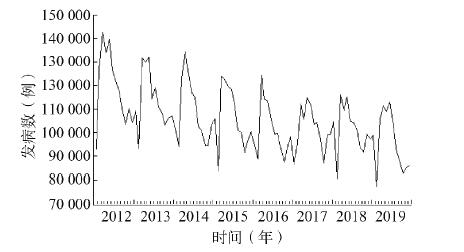Fluctuation analysis and long-term and short-term prediction of class B respiratory infectious diseases in China
-
摘要:
目的 分析中国乙类呼吸道传染病发病的波动规律并进行长期趋势预测和短期预测,为制定防控策略提供科学依据。 方法 利用CensusX-12季节调整法和Hodrick-Prescott(HP)滤波法对中国乙类呼吸道传染病发病的月度时间序列数据进行分解,将时间序列中不规则变动、季节因素、趋势因素和循环因素分离,研究其波动规律,同时结合回归模型和Holt-Winter季节指数平滑模型实现长期趋势预测和短期预测。 结果 乙类呼吸道传染病的发病情况受季节因素影响较大,呈现循环周期性波动,发病的长期趋势为逐年下降,同时利用Holt-Winter季节指数平滑模型取得了很好的短期预测效果。 结论 CensusX-12季节调整法和HP滤波法可较好的分析中国乙类呼吸道传染病发病的季节特征和循环周期特征,实现长期趋势预测和短期预测,对疾病防控策略的制定有指导意义。 -
关键词:
- 季节调整 /
- 循环周期分析 /
- Holt-Winter季节指数平滑模型 /
- 长期趋势预测
Abstract:Objective To analyze the fluctuation law of the incidence of class B respiratory infectious diseases in China,to make long-term trend prediction and short-term prediction,and to provide scientific basis for formulating prevention and control strategies. Methods Based on CensusX-12 seasonal adjustment method and the Hodrick-Prescott (HP)filtering method,the monthly time series data of the incidence of class B respiratory infectious diseases in China was separated.The irregular changes,seasonal factors,trend factors and circulation factors were separated in order to study its fluctuation rules.The long-term trend prediction and short-term prediction were realized by using the regression model and the Holt-Winter seasonal index smoothing model. Results The incidence of class B respiratory infections diseases was greatly affected by seasonal factors,and showing cyclical fluctuations.The long-term trend of the incidence was found to be decreasing year by year.Meanwhile,the Holt-Winter seasonal index smoothing model was used to obtain a good short-term prediction effect. Conclusions Censusx-12 seasonal adjustment method and HP filter method can be effectively used to analyze the seasonal characteristics and circulation cycle characteristics of class B respiratory infectious diseases in China,and achieve long-term trend prediction and short-term prediction.The results have guiding significance for the formulation of disease prevention and control strategies. -
表 1 2012-2019 年中国乙类呼吸道传染病发病循环周期表
Table 1. Table of the circulation cycle of class B respiratory infectious diseases in China from 2012 to 2019
周期 波峰时间 波谷时间 周期长度(月) 2013年7月至2015年1月 2013年10月 2014年8月 18 2015年2月至2017年5月 2015年5月 2016年11月 27 表 2 2012-2019年中国乙类呼吸道传染病发病年平均趋势值
Table 2. Periodic table of annual average trend value of class B respiratory infectiousdiseases in China from 2012 to 2019
年份 实际值 预测值 绝对误差 相对误差 2012 119 075 116 038 3 037 0.025 5 2013 113 378 113 086 292 0.002 5 2014 108 348 110 134 1 786 0.016 4 2015 106 147 107 182 1 035 0.009 7 2016 100 316 104 229 3 913 0.039 0 2017 100 839 101 277 438 0.004 3 2018 100 992 98 325 2 667 0.026 4 2019 96 549 95 373 1 176 0.012 1 2020 -- 92 421 -- -- 2021 -- 89 470 -- -- 2022 -- 86 518 -- -- -
[1] Lintusaari J, Gutmann MU, Kaski S, et al. On the identifiability of transmission dynamic models for infectious diseases[J]. Genetics, 2016, 202(3):911-918. DOI: 10.1534/genetics.115.180034. [2] 杨丽娟. 2004-2015年我国乙类传染病发病趋势的动态因子模型分析[D].合肥: 安徽医科大学, 2019.Yang LJ. Dynamic factor model analysis of the incidence trend of class B infectious diseases in China from 2004 to 2015[D]. Hefei: Anhui Medical University, 2019. [3] 牟瑾, 谢旭, 李媛, 等.将ARIMA模型应用于深圳市1980-2007年重点法定传染病预测分析[J].预防医学论坛, 2009, 15(11):1051-1052, 1055. DOI: 10.16406/j.pmt.issn.1672-9153.2009.11.011.Mou J, Xie X, Li Y, et al. Application of ARIMA model to prediction and analysis of key statutory infectious diseases in Shenzhen city from 1980 to 2007[J]. Prev Med Trib, 2009, 15(11):1051-1052, 1055. DOI: 10.16406/j.pmt.issn.1672-9153.2009.11.011. [4] 宁少奇, 陈飒, 曹磊, 等.陕西省2010-2016年猩红热流行特征分析及趋势预测[J].中华疾病控制杂志, 2018, 22(6):585-589. DOI: 10.16462/j.cnki.zhjbkz.2018.06.011.Ning SQ, Chen S, Cao L, et al. Analysis of epidemic characteristics and trend prediction of scarlet fever in Shaanxi Province from 2010 to 2016[J]. Chin J Dis Control Prev, 2018, 22(6):585-589. DOI: 10.16462/j.cnki.zhjbkz.2018.06.011. [5] 杨文姣, 肖俊玲, 丁国武. ARIMA模型和BP神经网络模型在甘肃省结核病发病率预测中的应用[J].中华疾病控制杂志, 2019, 23(6):728-732. DOI: 10.16462/j.cnki.zhjbkz.2019.06.021.Yang WJ, Xiao JL, Ding GW. ARIMA model and BP neural network model in the prediction of incidence rate of tuberculosis in Gansu province[J]. Chin J Dis Control Prev, 2019, 23(6):728-732. DOI: 10.16462/j.cnki.zhjbkz.2019.06.021. [6] 毛龙飞, 何茶清.集中度和圆形分布法在传染病季节性特征分析中的应用[J].中国卫生统计, 2014, 31(2):251-253. http://www.wanfangdata.com.cn/details/detail.do?_type=perio&id=zgwstj201402018Mao LF, He CQ. The application of concentration and circular distribution in the analysis of seasonal characteristics of infectious diseases[J]. Chin J Health Statistics, 2014, 31(2):251-253. http://www.wanfangdata.com.cn/details/detail.do?_type=perio&id=zgwstj201402018 [7] 杨春梅, 卢娟, 宫占威, 等.某部2004~2013年传染病发病规律分析及重点传染病预测[J].西北国防医学杂志, 2015, 36(7):455-458. DOI: 10.16021/j.cnki.1007-8622.2015.07.011.Yang CM, Lu J, Gong ZW, et al. Analysis of the incidence of infectious diseases and prediction of key infectious diseases in a certain department from 2004 to 2013[J]. Med J Natl Defend Forces Northwest China, 2015, 36(7):455-458. DOI: 10.16021/j.cnki.1007-8622.2015.07.011. [8] 安晓红.灰色系统GM(1, 1)模型在预测徐州市甲乙类呼吸道传染病发病趋势中的应用[J].江苏预防医学, 2019, 30(1):33-35. DOI: 10.13668/j.issn.1006-9070.2019.01.011.An XH. The application of grey system GM (1, 1) model in predicting the incidence trend of class A and B respiratory infectious diseases in Xuzhou[J]. Jiangsu J Prev Med, 2019, 30(1):33-35. DOI: 10.13668/j.issn.1006-9070.2019.01.011. [9] 唐广心, 张飞飞, 鲁苇葭, 等.指数平滑法在麻疹发病率预测中的应用[J].实用预防医学, 2018, 25(6):757-759. DOI: 10.3969/j.issn.1006-3110.2018.06.034.Tang GX, Zhang FF, Lu WJ, et al. Application of exponential smoothing in prediction of incidence rate of measles[J]. Pract Prev Med, 2018, 25(6):757-759. DOI: 10.3969/j.issn.1006-3110.2018.06.034. [10] 杨辉.经济时间序列的季节调整[D].成都: 西南财经大学, 2016.Yang H. Seasonal adjustment of economic time series[D]. Chengdu: Southwest University of Finance and Economics, 2016. [11] 陈飞, 高铁梅.结构时间序列模型在季节调整方面的应用-与X-12季节调整方法的比较分析[J].系统工程理论与实践, 2007, 27(11):7-14. DOI: 10.3321/j.issn:1000-6788.2007.11.002.Chen F, Gao TM. Application of structural time series model in seasonal adjustment-a comparative analysis with X-12 Seasonal Adjustment Method[J]. Systems Engineering-Theory & Practice, 2007, 27(11):7-14.DOI: 10.3321/j.issn:1000-6788.2007.11.002. [12] 叶锋, 谢娟, 马敬桂.基于HP滤波法的我国猪肉价格波动周期性探究[J].价格月刊, 2017, (10):27-30. DOI: 10.14076/j.issn.1006-2025.2017.10.06.Ye F, Xie J, Ma JG. Research on periodicity of pork price fluctuation based on HP filter method[J]. Prices Monthly, 2017(10):27-30.DOI: 10.14076/j.issn.1006-2025.2017.10.06. [13] 顾蓉艳, 张玲, 宋肖肖, 等.基于季节性指数平滑法的学校因病缺课预测研究[J].中华疾病控制杂志, 2019, 23(7):845-849, 855. DOI: 10.16462/j.cnki.zhjbkz.2019.07.020.Gu RY, Zhang L, Song XX, et al. Prediction of school absence due to illness based on seasonal index smoothing method[J]. Chin J Dis Control Prev, 2019, 23, (7):845-849, 855. DOI: 10.16462/j.cnki.zhjbkz.2019.07.020. [14] Liu H, Li CX., Shao YQ, Forecast of the trend in incidence of acute hemorrhagic conjunctivitis in China from 2011-2019 using the Seasonal Autoregressive Integrated Moving Average (SARIMA) and Exponential Smoothing (ETS) models[J]. J Infect Public Health, 2020, 13(2):287-294. DOI: 10.1016/j.jiph.2019.12.008. [15] 史芸萍, 李刚, 刘洋, 等.北京市2015-2018年法定呼吸道传染病流行特征分析[J].中华疾病控制杂志, 2020, 24(1):97-100, 113. DOI: 10.16462/j.cnki.zhjbkz.2020.01.019.Shi YP, Li G, Liu Y, et al. Analysis on the epidemic characteristics of statutory respiratory infectious diseases in Beijing from 2015 to 2018[J]. Chin J Dis Control Prev, 2020, 24(1):97-100, 113. DOI: 10.16462/j.cnki.zhjbkz.2020.01.019. [16] 时照华, 苏虹, 秦凤云, 等. ARIMA模型在常见呼吸道传染病疫情预测中的应用[J].安徽医科大学学报, 2013, 48(7):783-786. DOI:10.19405/j.cnki.issn1000-1492.2013.07.016.Shi ZH, Su H, Qin FY, et al. Application of ARIMA model in the prediction of common respiratory infectious diseases[J]. Acta Universitatis Medicinalis Anhui, 2013, 48(7):783-786. DOI: 10.19405/j.csn.issn1000-1492.2013.07.016. -





 下载:
下载:







